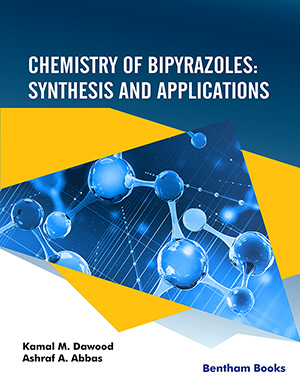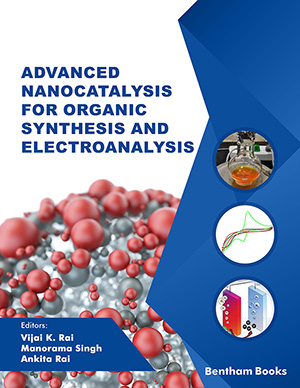
Abstract
Chemical modification of proteins with bioorthogonal reaction and site-selectivity has been increasingly recognized for exquisite control over homogeneity and geometry, allowing more complex and various applications of proteins. The development of novel bioorthogonal reactions and their adaptation to protein chemistry in the form of genetically encoded non-natural amino acids are fueling widespread use of the so-called ‘bioorthogonal protein conjugation’. Site-specific incorporation of a non-natural amino acid technique precisely delivers a bioorthogonal group to any defined site in response to an expanded genetic code where a selective bond-forming reaction equips proteins with novel functionalities in a chemically well-defined and homogeneous manner.
Keywords: Non-natural amino acid, bioorthogonal reaction, site-specific incorporation, bioconjugation, protein evolution, genetic code.
Current Organic Chemistry
Title:Bioorthogonal Modification of Proteins Using Genetically Encoded Non-Natural Amino Acids
Volume: 20 Issue: 11
Author(s): Sung In Lim and Inchan Kwon
Affiliation:
Keywords: Non-natural amino acid, bioorthogonal reaction, site-specific incorporation, bioconjugation, protein evolution, genetic code.
Abstract: Chemical modification of proteins with bioorthogonal reaction and site-selectivity has been increasingly recognized for exquisite control over homogeneity and geometry, allowing more complex and various applications of proteins. The development of novel bioorthogonal reactions and their adaptation to protein chemistry in the form of genetically encoded non-natural amino acids are fueling widespread use of the so-called ‘bioorthogonal protein conjugation’. Site-specific incorporation of a non-natural amino acid technique precisely delivers a bioorthogonal group to any defined site in response to an expanded genetic code where a selective bond-forming reaction equips proteins with novel functionalities in a chemically well-defined and homogeneous manner.
Export Options
About this article
Cite this article as:
Lim In Sung and Kwon Inchan, Bioorthogonal Modification of Proteins Using Genetically Encoded Non-Natural Amino Acids, Current Organic Chemistry 2016; 20 (11) . https://dx.doi.org/10.2174/1385272819666150810220630
| DOI https://dx.doi.org/10.2174/1385272819666150810220630 |
Print ISSN 1385-2728 |
| Publisher Name Bentham Science Publisher |
Online ISSN 1875-5348 |
Call for Papers in Thematic Issues
Advances of Heterocyclic Chemistry with Pesticide Activity
Global food safety and security will continue to be a global concern for the next 50 years and beyond. Plant diseases have had a significant impact on food safety and security throughout the entire food chain, from primary production to consumption. While conventional chemical pesticides have been traditionally used for ...read more
Carbohydrates conversion in biofuels and bioproducts
Biomass pretreatment, hydrolysis, and saccharification of carbohydrates, and sugars bioconversion in biofuels and bioproducts within a biorefinery framework. Carbohydrates derived from woody biomass, agricultural wastes, algae, sewage sludge, or any other lignocellulosic feedstock are included in this issue. Simulation, techno-economic analysis, and life cycle analysis of a biorefinery process are ...read more
Catalytic C-H bond activation as a tool for functionalization of heterocycles
The major topic is the functionalization of heterocycles through catalyzed C-H bond activation. The strategies based on C-H activation not only provide straightforward formation of C-C or C-X bonds but, more importantly, allow for the avoidance of pre-functionalization of one or two of the cross-coupling partners. The beneficial impact of ...read more
Cutting-edge technology for the development of electrochemical sensors
Electrochemistry based point of care diagnostics is a powerful tool which can revolutionize the current concept of personalize health care industry. There have been several efforts to amalgamate cutting edge technologies (nanotechnology, surface technology, anti-biofouling strategies) while developing assays. The success of each electrochemical sensor is very dependable upon how ...read more
Related Journals
 36
36 2
2 1
1 1
1
- Author Guidelines
- Graphical Abstracts
- Fabricating and Stating False Information
- Research Misconduct
- Post Publication Discussions and Corrections
- Publishing Ethics and Rectitude
- Increase Visibility of Your Article
- Archiving Policies
- Peer Review Workflow
- Order Your Article Before Print
- Promote Your Article
- Manuscript Transfer Facility
- Editorial Policies
- Allegations from Whistleblowers
- Announcements
Related Articles
-
Nicotine, Body Weight and Potential Implications in the Treatment of Obesity
Current Topics in Medicinal Chemistry New Pharmacological Perspectives and Therapeutic Potential of PPAR-γ Agonists
Current Pharmaceutical Design Therapeutic Immunoconjugates. Which Cytotoxic Payload: Chemotherapeutic Drug (ADC) or Radionuclide (ARC) ?
Current Cancer Therapy Reviews Aptamers Against Cell Surface Receptors: Selection, Modification and Application
Current Medicinal Chemistry The Optimal Diagnosis of Urothelial Carcinoma of the Bladder
Current Cancer Therapy Reviews Modulation of k-Ras Signaling by Natural Products
Current Medicinal Chemistry Immunotherapy and Targeted Therapy Combinations in Renal Cancer
Current Clinical Pharmacology Role of FoxM1 in the Progression and Epithelial to Mesenchymal Transition of Gastrointestinal Cancer
Recent Patents on Anti-Cancer Drug Discovery How Do Microtubule-Targeted Drugs Work? An Overview
Current Cancer Drug Targets Control of Stemness by Fibroblast Growth Factor Signaling in Stem Cells and Cancer Stem Cells
Current Stem Cell Research & Therapy Disposition and Interaction of Biotherapeutics in Pediatric Populations
Current Drug Metabolism 3-Bromopyruvate: A New Targeted Antiglycolytic Agent and a Promise for Cancer Therapy
Current Pharmaceutical Biotechnology Merging Traditional Chinese Medicine with Modern Drug Discovery Technologies to Find Novel Drugs and Functional Foods
Current Drug Discovery Technologies Secretory Clusterin: A Promising Target for Chemoresistance of Hepatocellular Carcinoma
Mini-Reviews in Medicinal Chemistry Molecular Biotheranostic Approaches of Cancers Using LAT Kit Probes
Current Medical Imaging A Missed Proteome in Living Organisms: A Hyppo System
Current Proteomics Telomere/Telomerase System: A New Target of Statins Pleiotropic Effect?
Current Vascular Pharmacology Circulating Levels of Soluble Angiogenic Factors in Multiple Myeloma: Correlation with Parameters of Disease Activity and Prognosis
Current Angiogenesis (Discontinued) Human Sirtuins: An Overview of an Emerging Drug Target in Age-Related Diseases and Cancer
Current Drug Targets Olive Oil and Apoptosis of Cancer Cells
Current Nutrition & Food Science























